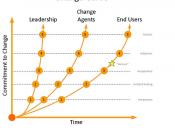This essay first looks into the reasons why organisations decide to change, for example new I.T. and new policies. It then goes on to state why there is resistance to change, both within the organisation itself and the individual, when on the surface it can be seen as the only course of action to take. For the individual there's the fear of the unknown, and the organisation is affected by it's own culture. Organisational culture is then explored in more depth, as it is a large contributing factor to the resistance of change. The essay then looks into ways to counteract the resistance and various strategies the managers can adopt, like motivating their staff through promotions and pay incentives. Then a real working example of an organisational change is reviewed in an NHS Trust hospital.
Organisational change is a necessary and vital part of any company, as it ensures the continuing development and renewing of a firm in order to keep up with competitors and to satisfy the customers.
There are many reasons why companies decide to change their inner workings. Contributing factors from outside the organisation are, the introduction of new technology and materials, the changing needs and wants of customers, economic changes, political changes and the introduction of new government policies, and the publics changing interests in cultural activities. As well as these external factors, there are also internal factors that come from within the organisation itself. These are, innovations in the product design and manufacturing, new senior managers with new ideas, low staff morale that leads to poor performance, stress and high staff turnover, with unsatisfactory skill levels that suggests more training is required. Change is a natural progression and should be seen as a positive move for an organisation. In 1951 Kurt Lewin introduced his 'three...


